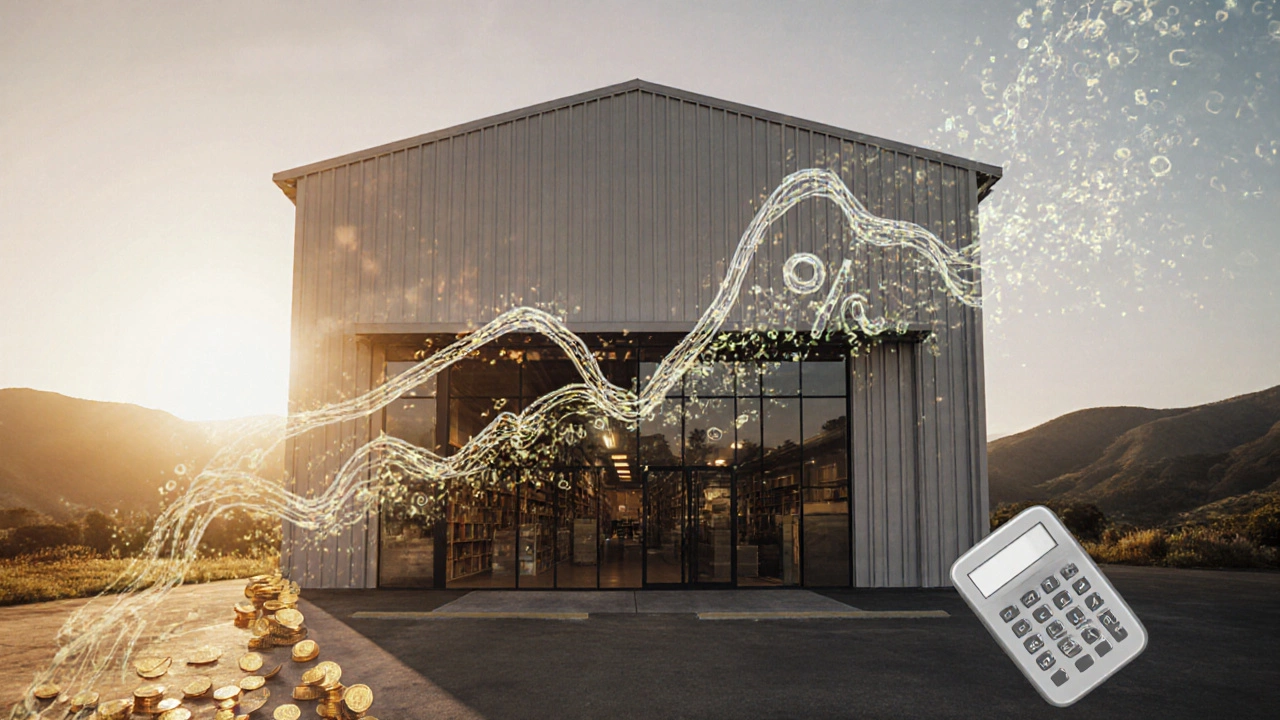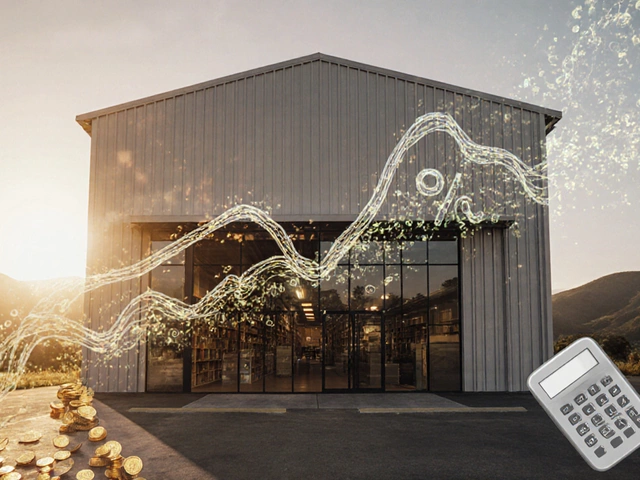Good Yield for Commercial Property: What’s a Strong Cap Rate?

Commercial Property Cap Rate Calculator
Calculate Your Property Cap Rate
Enter the details below to calculate the capitalization rate (cap rate) for a commercial property.
Your Cap Rate Results
Net Operating Income (NOI):
NZ$0
Capitalization Rate (Cap Rate):
0%
Interpretation: A cap rate of 0% indicates -.
Typical Cap Rates in New Zealand (2025)
| Property Type | Auckland | Wellington | Christchurch | Interpretation |
|---|---|---|---|---|
| Office (Class A) | 4.5–5.5% | 5.0–6.0% | 5.5–6.5% | Low-risk, strong tenant demand |
| Retail (Prime) | 5.0–6.0% | 5.5–6.5% | 6.0–7.0% | Depends on foot traffic and consumer confidence |
| Industrial/Warehouse | 6.5–7.5% | 6.0–7.0% | 5.5–6.5% | Generally high demand due to e-commerce growth |
| Mixed-Use (equipped with residential) | 5.5–6.5% | 6.0–7.0% | 6.5–7.5% | Blend of stability and upside from residential rents |
When you hear investors talk about a "good" return on a shop, office block, or warehouse, they’re usually referring to the commercial property yield. But what number actually signals a solid investment, and why does it swing from one market to another? This guide breaks down the math, the market forces, and the benchmarks you need to decide if a deal meets your expectations.
What Exactly Is a Yield (or Cap Rate)?
In plain English, a yield tells you how much cash an asset generates each year compared to what you paid for it. In commercial real estate the term most people use is "capitalisation rate" or Cap Rate is the ratio of a property’s Net Operating Income to its current market value. The formula is simple:
- Calculate Net Operating Income (NOI).
- Divide NOI by the purchase price or market valuation.
The result is expressed as a percentage. If a warehouse produces NZ$200,000 of NOI and you bought it for NZ$2,000,000, the cap rate is 10%.
Key Numbers You Need to Know
Getting a reliable cap rate hinges on a handful of underlying figures. Below are the core entities, each introduced with microdata for easy indexing.
- Net Operating Income is the total rental and other income less operating expenses, but before debt service and taxes.
- Gross Rental Income is the total rent collected before any deductions.
- Operating Expenses are costs to run the building, such as property management, insurance, rates, and maintenance.
- Vacancy Rate measures the percentage of rentable space that is empty at any given time.
- Location refers to the geographic area, accessibility, and surrounding economic activity that influence demand and rent levels.
- Property Type includes office, retail, industrial, mixed‑use, and specialty assets, each with its own risk‑return profile.
- Market Cycle is the phase of expansion, peak, contraction, or recovery that a regional economy is experiencing.
- Risk Premium denotes the extra return investors demand for perceived higher risk, often reflected in higher cap rates.
Typical Yield Ranges in NewZealand (2025)
Yield expectations differ by city, asset class, and risk level. Below is a snapshot of what seasoned investors see as “good” in 2025:
| Property Type | Auckland | Wellington | Christchurch | Interpretation |
|---|---|---|---|---|
| Office (ClassA) | 4.5‑5.5% | 5.0‑6.0% | 5.5‑6.5% | Low‑risk, strong tenant demand |
| Retail (Prime) | 5.0‑6.0% | 5.5‑6.5% | 6.0‑7.0% | Depends on foot traffic and consumer confidence |
| Industrial/Warehouse | 6.5‑7.5% | 6.0‑7.0% | 5.5‑6.5% | Generally high demand due to e‑commerce growth |
| Mixed‑Use (equipped with residential) | 5.5‑6.5% | 6.0‑7.0% | 6.5‑7.5% | Blend of stability and upside from residential rents |
In this table, a cap rate under 5% in Auckland’s prime office market is typically viewed as “good” because it signals low risk and solid long‑term cash flow. Conversely, a 7% yield on an industrial building in Christchurch is also considered good, reflecting higher risk and potentially higher growth.

How to Calculate Your Own Yield
Follow these steps to arrive at a realistic figure for any property you’re eyeing:
- Gather the latest rent roll. Add any ancillary income (parking, signage, service fees).
- Estimate the vacancy rate based on local market data. Subtract the projected vacancy loss from gross rent.
- Sum all operating expenses: property management fees (usually 5‑8% of gross rent), insurance, rates, utilities payable by landlord, and a reserve for capital expenditures.
- Calculate NOI = (Gross Rent × (1-Vacancy Rate)) - Operating Expenses.
- Determine the purchase price or current market valuation. Use a recent comparable sale if the property isn’t listed.
- Apply the cap rate formula: Cap Rate = NOI ÷ Purchase Price × 100%.
Let’s illustrate with a real‑world scenario. An Auckland retail strip earns NZ$1.2million gross rent. The local vacancy rate for similar assets is 8%, and operating expenses total NZ$300,000.
- Effective Gross Income = NZ$1.2M × (1-0.08) = NZ$1.104M.
- NOI = NZ$1.104M - NZ$0.3M = NZ$804,000.
- If the asking price is NZ$15M, Cap Rate = NZ$804,000 ÷ NZ$15,000,000 = 5.36%.
Factors That Push Yields Higher or Lower
Understanding why two identical‑type buildings can have wildly different yields helps you spot bargains or avoid traps.
- Location premium: Central business districts (CBDs) command lower cap rates because demand is steady and tenants are often credit‑worthy.
- Tenant quality: Long‑term leases with blue‑chip occupants reduce perceived risk, pulling yields down.
- Lease structure: Triple‑net (NNN) leases shift most expenses to the tenant, lifting NOI and thus lowering the cap rate.
- Age and condition: Newer buildings require less immediate cap‑ex, so investors accept smaller yields.
- Market interest rates: When the Reserve Bank of NewZealand hikes the official cash rate, required yields rise to keep returns above borrowing costs.
- Economic outlook: A strong GDP growth forecast tends to compress yields across the board.
When a Yield Is Too High - Red Flags
A high cap rate can look tempting, but it often signals trouble. Watch out for:
- Excessive vacancy: If an asset is void 20‑30% of the time, the high yield merely compensates for lost rent.
- Escalating expenses: Buildings with deferred maintenance may need costly upgrades that erode cash flow.
- Unstable tenant base: Short‑term leases in a volatile sector (e.g., pop‑up retail) increase turnover risk.
- Regulatory pressure: Zones under new zoning changes or stricter environmental standards could hit operating costs.

Improving the Yield on an Existing Asset
If you already own a property that’s underperforming, here are practical levers you can pull:
- Boost rents: Conduct a market rent review, upgrade finishes, or add value‑added services (e‑mail signage, shared amenities).
- Reduce vacancy: Offer flexible lease terms, improve marketing, or partner with a specialist broker.
- Trim operating costs: Negotiate service contracts, invest in energy‑efficient lighting, or implement a preventative maintenance schedule.
- Re‑structure leases: Shift to NNN where feasible, or add rent‑on‑escalation clauses tied to CPI.
- Refinance: Lock in a lower interest rate, freeing up cash flow that can be reinvested into the asset.
Each tweak can raise NOI by a few percent, which directly lifts the cap rate and overall return.
Quick Checklist - Is the Yield Good for You?
- Does the cap rate fall within the typical range for the property type and location?
- Are the underlying assumptions (vacancy, expenses) realistic and supported by recent market data?
- Is the tenant mix stable and financially strong?
- How does the required yield compare to your cost of capital?
- Can you add value to improve the yield further?
If you can answer “yes” to most of these, the yield is likely a good one for your investment goals.
Frequently Asked Questions
What is the difference between gross yield and net yield?
Gross yield uses total rental income before any expenses, while net yield (or cap rate) deducts operating costs, vacancy loss, and other outlays. Net yield gives a truer picture of cash flow.
How does the Reserve Bank’s cash rate affect commercial yields?
When the cash rate rises, borrowing becomes more expensive. Investors then demand higher yields to compensate for the increased financing cost, pushing cap rates up across most sectors.
Is a lower cap rate always better?
Not necessarily. A low cap rate signals low risk, but it also means lower cash returns. If your investment horizon is short or you need higher cash flow, a slightly higher yield might suit you better.
Can I compare cap rates across different property types?
Direct comparison is tricky because each asset class carries its own risk profile. For example, industrial properties usually have higher cap rates than prime office because they’re seen as riskier but offer growth potential.
What sources provide reliable vacancy and rent data in NewZealand?
Industry reports from CoreLogic, Real Estate Institute of NewZealand (REINZ), and quarterly market surveys from major brokerage firms are the go‑to references for up‑to‑date vacancy and rent trends.
Bottom line: A "good" commercial property yield isn’t a fixed number-it’s a range that reflects location, asset type, tenant quality, and market conditions. By crunching the right numbers and weighing the risk factors, you can decide whether a particular cap rate meets your investment goals.







Write a comment